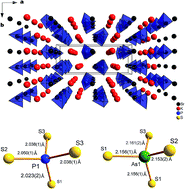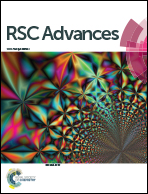Wide band gap design of new chalcogenide compounds: KSrPS4 and CsBaAsS4†
Abstract
Recently, the exploration of infrared nonlinear optical (IR NLO) materials has mainly focused on chalcogenide compounds. However, their practical applications are often hampered by the low laser damage thresholds (LDTs). It is known that wide band gaps can significantly enhance the LDTs of materials, and the introduction of alkali and alkaline earth cations would broaden the band gap. Accordingly, in this work two new compounds KSrPS4 and CsBaAsS4 with both alkali and alkaline earth cations were synthesized successfully. Both compounds crystallize in the space group Pnma (62) of the orthorhombic system, and the structures consist of isolated PnS4 (Pn = P, As) tetrahedra with the interstices occupied by K (or Cs) and Sr (or Ba) atoms, respectively. The band gaps of compounds were determined by different methods. The UV-visible diffuse reflectance spectra revealed that the band gaps of KSrPS4 and CsBaAsS4 are larger than 3.62 eV and 2.86 eV, respectively. The band gaps are primarily determined by the PnS4 tetrahedra.



 Please wait while we load your content...
Please wait while we load your content...